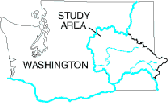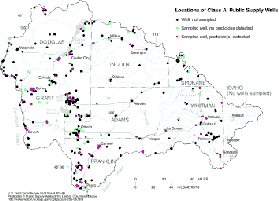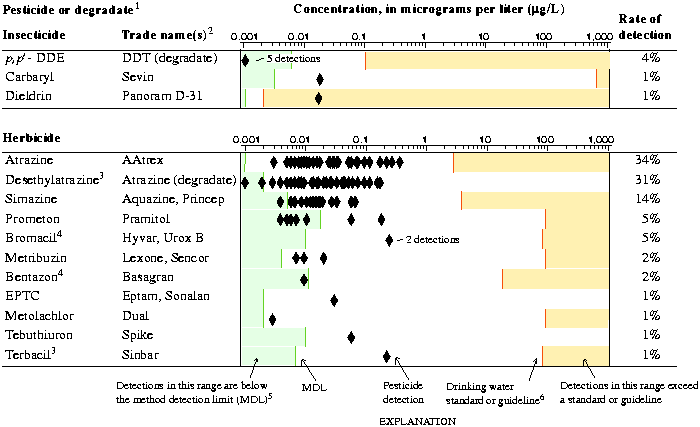
Central Columbia Plateau NAWQA Study - Publications
USGS Fact Sheet 205-96
Top/Summary | What pesticides were detected? | What factors influence... | Combinations of pesticides | Are these results representative... | References

This fact sheet presents U.S. Geological Survey (USGS) results from sampling Central Columbia Plateau public supply wells for pesticides.
In 1994, the USGS cooperated with the Washington State Department of Health (WDOH) in the first statewide assessment of the vulnerability of Washington public supply wells to pesticides. Samples were collected from 1,326 public supply wells across Washington State. In the Central Columbia Plateau, WDOH contract laboratories analyzed samples from 302 wells, while 138 duplicate samples were analyzed by the USGS using laboratory techniques that can detect very low concentrations of pesticides. Results were used by the WDOH for a risk analysis on which to base monitoring waivers, and by the USGS to assess the quality of ground water in the Central Columbia Plateau.

Locations of Class A* Public Supply Wells (118k GIF)
The map shows 500 Class A public supply wells, including two groups of wells sampled by the USGS.

Pesticide detections in randomly selected wells and high-risk wells
Top/Summary | What pesticides were detected? | What factors influence... | Combinations of pesticides | Are these results representative... | References
The combined table and graph below show concentrations of 14 pesticides detected in 138 public supply wells in the Central Columbia Plateau. This study analyzed primarily agricultural pesticides, as 61% of the Central Columbia Plateau is agricultural land. For a complete list of pesticides (insecticides and herbicides) analyzed and their detection limits, see Wagner and others, 1996.

Insecticide Trade names(s)2 | Herbicide Trade name(s)2
-------------------------------------+-----------------------------------------
Azinphos-methyl Guthion | 2,6-Diethylanaline Alachlor (degradate)
Carbofuran3 Furadan | Alachlor Lasso
Chlorpyrifos Genpest, Lorsban | Benfluralin Balan, Benefin
Diazinon several | Butylate Sutan +, Genate Plus
Disulfoton Di-Syston | Cyanazine Bladex
Ethoprop Mocap | DCPA Dacthal
Fonofos Dyfonate | Ethalfluralin Sonalan, Curbit EC
alpha-HCH Lindane (impurity) | Linuron Lorox, Linex
gamma-HCH Lindane | Molinate Ordram
Malathion several | Napropamide Devrinol
Methyl parathion Penncap-M | Pebulate Tillam
Parathion several | Pendimethalin Prowl, Stomp
cis-Permethrin Ambush, Pounce | Pronamide Kerb
Phorate Thimet, Rampart | Propachlor Ramrod
Propargite Comite, Omite | Propanil Stampede
Terbufos Counter | Thiobencarb Bolero
| Triallate Far-Go
| Trifluralin Treflan, Trilin
Footnotes to pesticide detection tables: 1Break-down product. This study and others (Kolpin and others, 1996) found that degradates of some common herbicides are detected at least as frequently as the parent pesticide. 2Use of trade names is for descriptive purposes and does not imply endorsement by the U.S. Geological Survey. Parent compound names are included for degradates. 3Concentrations for these compounds are qualitatively identified and reported as estimated values because of problems with gas chromatography or extraction. 4A subset of the samples (43/138) was analyzed for 41 additional pesticides. 5The MDL is the smallest concentration of a compound that the laboratory can detect with 99% confidence. Detections below the MDL are identified and reported as approximate concentrations. 6For atrazine and simazine, standards are EPA maximum contaminant levels (MCLs). For p,p'-DDE and dieldrin, guidelines are risk-specific doses (RSDs), concentrations corresponding to a 1 in one million increased chance of developing cancer. Guidelines for other pesticides are concentrations considered safe for a 70-kilogram adult in 70 years of exposure (Nowell and Resek, 1994; U.S. Environmental Protection Agency, 1996). [Back to pesticide detection table]
Top/Summary | What pesticides were detected? | What factors influence... | Combinations of pesticides | Are these results representative... | References
What factors influence pesticide concentration and detection?
Concentrations of agricultural pesticides in ground water are influenced by a number of interrelated factors:
An analysis of public supply wells from across Washington State (summarized by Ryker and Williamson, 1996) found that three factors correlated with pesticide detection:
In Central Columbia Plateau public supply wells, the two factors most
clearly related to pesticide detection are the concentration of nitrate
detected in the well and the well depth (see bar graphs below).
Agricultural land use is an important factor in the Central Columbia
Plateau; however, to correlate specific types of agriculture with pesticide
detection would require more current and detailed land-use data than are
currently available.
Is my drinking water vulnerable?
All of the above factors, and also site-specific factors such as well construction, affect whether pesticides get into well water.
Agricultural fertilizers are the primary source of nitrate in ground water. Nitrate concentrations greater than 2-3 mg/L in well water indicate that chemicals applied to the land surface are reaching the ground water system, so detection of pesticides in these wells may be more likely.
This relationship between nitrate concentration and pesticide detection may help identify wells at risk for contamination by pesticides. Laboratory analysis of nitrate is simpler and less costly than analysis of pesticides. Consequently, many more Central Columbia Plateau wells have been sampled for nitrate (see Ryker and Jones, 1995).
This graph shows that, in general, Central Columbia Plateau wells with lower nitrate concentrations have a lower rate of pesticide detection.
As pesticides travel from the land surface down through the ground-water system, they may degrade. Many modern pesticides are designed to degrade rapidly, to reduce contamination of ground water. However, shallow wells can take in water containing pesticides that have not yet degraded. Shallow wells therefore tend to have a higher rate of pesticide detection.
However, even water from deep public supply wells can contain pesticides. This could be due to poor well construction, high pumpage rates (drawing more ground water into the well), or local ground-water pathways that allow water to move quickly to greater depths.
This graph shows that, in general, deeper wells in the Central Columbia Plateau have a lower rate of pesticide detection.
Top/Summary | What pesticides were detected? | What factors influence... | Combinations of pesticides | Are these results representative... | References
Combinations of pesticides
Multiple pesticides were detected in 66% of the 62 wells with pesticide detections. No well had more than 6 pesticides detected.
Health effects of combinations of pesticides in drinking water are not well understood. However, just as the effectiveness of pesticides may increase or decrease when mixed together for agricultural use, the toxic effect on humans may change when combinations of pesticides are present in drinking water. Currently, health standards are set only for individual compounds.
The EPA is considering establishing health standards for combinations of triazine pesticides, and for their individual degradation products (U.S. Environmental Protection Agency, 1994).
In this study, three of the five most frequently detected pesticides in public supply wells were members of the triazine family:
Triazine pesticides were also the compounds most commonly detected together in Central Columbia Plateau public supply wells.
In contrast, p,p'-DDE, the fifth most detected compound in this study, was never detected in combination with other pesticides. p,p'-DDE is a degradation product of DDT, which was discontinued for use in the United States in 1973. Wells where only p,p'-DDE is detected, and not the more modern pesticides, may be taking in older water that predates use of triazine pesticides. This scenario assumes that the more recently applied pesticides have not yet moved deep enough to be taken in by these wells.
Top/Summary | What pesticides were detected? | What factors influence... | Combinations of pesticides | Are these results representative... | References
Are these findings representative of ground-water quality in the
Central Columbia Plateau?
The USGS National Water-Quality Assessment (NAWQA) program is designed to assess the status of, and trends in, the Nation's water resources. The NAWQA design includes a Study-Unit Survey intended to characterize the quality of the ground-water resources used in the study area. Wells are randomly selected to ensure a representative sample population.
This study's random sampling of public supply wells fulfills the NAWQA Study-Unit Survey for the Central Columbia Plateau. The sampling results appear to be representative of the area's ground-water quality: similar pesticides and concentrations have been detected in shallow domestic wells, monitoring wells, and surface waters sampled by other components of NAWQA (Roberts and Jones, 1996a and b; Wagner and others, 1995).
The pesticides reported here are not the only contaminants in the ground water of the Central Columbia Plateau. The WDOH contract laboratories analyzed for, and detected, a slightly different group of pesticides (Washington State Department of Health, 1995). WDOH sampling results are not reported here because the contract laboratories were unable to detect concentrations as low as many of the USGS pesticide detections. WDOH sampling results were otherwise very similar to the USGS sampling results (Ryker and Williamson, 1996).
The NAWQA study also has detected additional pesticides, volatile organic compounds, and several other types of contaminants in Central Columbia Plateau public supply wells, domestic wells, and monitoring wells (Roberts and Jones, 1996a and b).
USGS Fact Sheet FS-205-96 by Sarah J. Ryker and Alex K. Williamson
References:
Kolpin, D.W., and others, 1996, Occurrence of selected pesticides and their metabolites in near-surface aquifers of the midwestern United States: Environmental Science and Technology, v.30, no.1, p. 335-340.
Nowell, L.H. and Resek, E.A., 1994, Summary of national standards and guidelines for pesticides in water, bed sediment, and aquatic organisms and their application to water-quality assessments: U.S. Geological Survey Open-File Report 94-44, 115 p.
Roberts, L.M. and Jones, J.L., 1996a, Agricultural pesticides found in ground water of the Quincy and Pasco Basins: U.S. Geological Survey Fact Sheet 240-95, 2 p.
Roberts, L.M. and Jones, J.L., 1996b, Pesticides found in ground water below orchards in the Quincy and Pasco Basins: U.S. Geological Survey Fact Sheet 171-96, 4 p.
Ryker, S.J. and Jones, J.L., 1995, Nitrate concentrations in ground water of the Central Columbia Plateau: U.S. Geological Survey Open-File Report 95-445, 4 p.
Ryker, S.J. and Williamson, A.K., 1996, Pesticides in public supply wells of Washington State: U.S. Geological Survey Fact Sheet 122-96, 2 p.
U.S. Environmental Protection Agency, November 1994, Atrazine, simazine, cyanazine; notice of initiation of special review: Federal Register, v.59, p. 60412-60443.
U.S. Environmental Protection Agency, February 1996, Drinking water regulations and health advisories: Washington, D.C., Office of Water, U.S. Environmental Protection Agency, EPA 822-R-96-001, 16 p.
Wagner, R.J., and others, 1996, Agricultural pesticide applications and observed concentrations in surface waters from four drainage basins in the Central Columbia Plateau, Washington and Idaho, 1993-94: U.S. Geological Survey Water-Resources Investigations Report 95-4285, 50 p.
Washington State Department of Health, Spring 1995, Preliminary Results of the Areawide Groundwater Monitoring Project: Washington State Department of Health, 9 p.
Zaugg, S.D., and others, 1995, Methods of analysis by the U.S. Geological Survey National Water Quality Laboratory--determination of pesticides in water by C-18 solid-phase extraction and capillary- column gas chromatography/mass spectrometry with selected-ion monitoring: U.S. Geological Survey Open-File Report 95-181, 49 p.
For health information, contact your water utility or county health agency, or the Washington State Department of Health: 1 (800) 521-0323.
For further technical information contact:
For a paper copy of this report, email: nawqa_ccpt_wa@usgs.gov